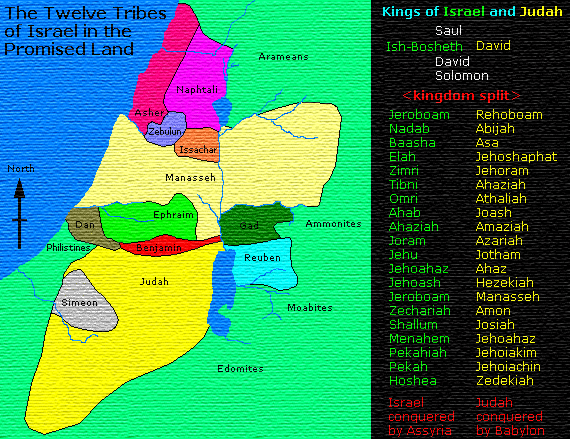Land of Canaan
Invasion and Conquest of Canaan (What kind of land is Canaan Geographically?)
The Conquest of Canaan
- The conquest of Eastern Palestine: leader, Moses.
1. The location of the land. From the Brook Arnon as far north as a parallel at Laish-dan, and from the Jordan River eastward to the Arabian Desert.
- Divisions of the land.
- Gilead: peopled by the southern Amorites; ruled by King Sihon.
- Bashan: peopled by the northern Amorites; ruled by King Og.
- On the southeast were the Midianites and Ammonites.
- Conquest of Gilead.
- Moses asked permission to pass thru the land; privilege was denied.
- Battle with King Sihon at Jahaz.
- Kin Sihon slain; Amorites defeated; Gilead possessed by the Israelites.
- Conquest of Bashan.
- Battle fought at Edrei.
- King Og slain and the district possessed by Israel.
- Conquest of Midian.
- League formed by Moabites and Midianites to resist the advances of Israel.
- Balaam summoned to curse Israel but his words turned to blessing.
- Isreal wars with the Midianites and Moabites and defeats them.
- Midianites annihilated in that part of the country.
- Moabites excluded from the congregation of Israel for ten generations.
- The conquest of Western Palestine: leader, Joshua
- The conquest of central Palestine.
- Peoples conquered: Hivites and Perizites, a peaceful people offering very little resistance.
- Outline of campaign.
- Camped at Gilgal.
- Jericho taken
- Defeat and final victory at Ai.
- Shechem taken, a Hivite city, memorial stone erected.
- Given obtains a pledge of protection.
1. Deceit discovered but pledge kept by Israel.
- The conquest of Southern Palestine: leader, Joshua
Introduction: Conquest easy so far because of lack of unity among Israel’s enemies. Because of the fear of Israel, Adonizedek, King of Jerusalem, and the kings of Hebron, Jarmuth, Lachish, and Eglon form an alliance.
- Outline of campaign.
- Joshua calls together his warriors; leaves Gilgal and makes a night march thru the mountain passes and comes upon the enemy near Beth-Horon.
- The most important battle in human history fought here, and one at which the sun and moon might well stand still, since the religious destiny of the world was at stake.
- The conquest of Canaan made certain thru this battle.
- The enemy pursued to Makkedsh where the 5 kings were captured and slain.
- Conquest completed latter by Caleb and Othniel.
- The conquest of Northern Palestine: leader, Joshua
- Occupied by a number of independent chiefs of whom the most powerful was Jabin, King of Hazor.
- King Jabin called together the associated tribes and their camp was pitched near Lake Merom.
- Outline of campaign.
- Joshua made a swift march up the Jordan Valley, attacked them suddenly and utterly defeated them.
- Burned the war chariots and make the horses useless.
- Marched thru the northern region, capturing cities and slaying rulers.
Note: This campaign closed the active military operations, so that the land rested from war; but for many years the strife was feebly continued, and it was not entirely finished until the reign of David.
B. Under the Divided Kingdom, etc.
THE EARLIEST INHABITANTS OF PALESTINE The early inhabitants of Canaan settled on both sides of Jordan. They were remembered by different names in various parts of the country but were doubtless of one race, whether Hamitic or Semitic is uncertain.
They were in their decline in Abraham’s day. REPHAIM - “lofty men’ - giants - (east of Sea of Galilee) ZUZIM - “tall ones” — Eastern Table Land (East of Dead Sea) EMIM - “terrible ones” - south of Zuzim-~ HORIM - “cave dwellers” or Horites - South of Dead Sea (lived in caves) AVIN - ‘dwellers in ruins” - in the Shefelah ANAKIM - “long necked ones” - Hebron. It was this particular race that struck terror to the Israelites spies (Num. 13) Goliath, whom David killed, and his brother belonged to this race. TRIBES OF PATRIARCHAL ERA
These earliest races were nearly all subdued by later tribes of Hamitic origin called Canaanites. These were divided into the following:
ZIDONIANS - By Mediterranean Sea at north, between Mt. Lebanon and CANAANITES - Maritime Plain on both sides of Mt. Camel, Plain of Esdraelon, Sharon, and Jordan Valley (occupied richest and most valuable portions of land).
PHILISTINES — South of Canaanites on Maritime Plain-most dangerous of Israel’s enemies during the Judges.
HITTITES — One group near Sea of Galilee — the other around Hebron. These were peaceful with the patriarchs and of them Abraham purchased his family sepu1chre from them.
GIRGASHITE - - Possibly west of Sea of Galilee. HIVITES - South of Mt. Cannel. PERRIZITES - Northern portion of Shefelah JEBUSITES - Mountains near Jerusalem AMMORITES - Most powerful of all - wilderness between Hebron and Dead Sea. NATIONS AT TIME OF CONQUEST
AMMORITES - Eastern Table land
MOABITES - (settled in cities) and AMMONITES (wanderers) - descendants of Lot.
SURROUNDI1NG NATIONS Bordering on lands of Canaan before-the Conquest
HIVITES, ARRITES, SINITES, ARVADITES & HAMATBITES North AMMONITES – Southeast AMALEKITES – Kenites and Edomites - South


No Comments